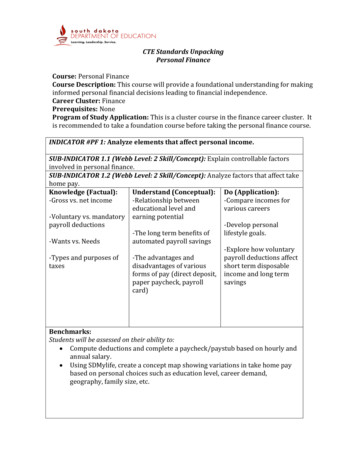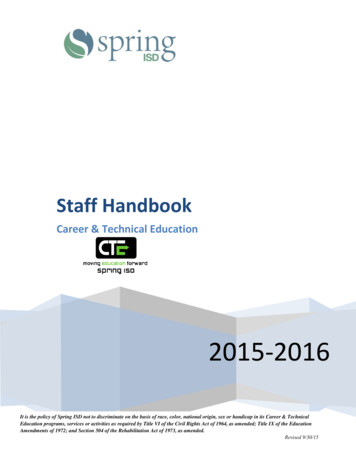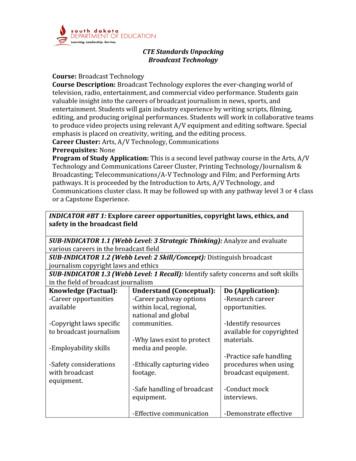CTE Standards Unpacking Personal Finance
CTE Standards UnpackingPersonal FinanceCourse: Personal FinanceCourse Description: This course will provide a foundational understanding for makinginformed personal financial decisions leading to financial independence.Career Cluster: FinancePrerequisites: NoneProgram of Study Application: This is a cluster course in the finance career cluster. Itis recommended to take a foundation course before taking the personal finance course.INDICATOR #PF 1: Analyze elements that affect personal income.SUB-INDICATOR 1.1 (Webb Level: 2 Skill/Concept): Explain controllable factorsinvolved in personal finance.SUB-INDICATOR 1.2 (Webb Level: 2 Skill/Concept): Analyze factors that affect takehome pay.Knowledge (Factual):Understand (Conceptual): Do (Application):-Gross vs. net income-Relationship between-Compare incomes foreducational level andvarious careers-Voluntary vs. mandatory earning potentialpayroll deductions-Develop personal-The long term benefits oflifestyle goals.-Wants vs. Needsautomated payroll savings-Explore how voluntary-Types and purposes of-The advantages andpayroll deductions affecttaxesdisadvantages of variousshort term disposableforms of pay (direct deposit, income and long termpaper paycheck, payrollsavingscard)Benchmarks:Students will be assessed on their ability to: Compute deductions and complete a paycheck/paystub based on hourly andannual salary. Using SDMylife, create a concept map showing variations in take home paybased on personal choices such as education level, career demand,geography, family size, etc.
Academic ConnectionsELA Literacy and/or Math StandardSample Performance Task Aligned to(if applicable, Science and/or Socialthe Academic Standard(s):Studies Standard):Math:A.SSE.3 Choose and produce anequivalent form of an expression toreveal and explain properties of thequantity represented by the expression.(Uses Modeling)ELA:9-10.RI.1 Cite strong and thoroughtextual evidence to support analysis ofwhat the text says explicitly as well asinferences drawn from the text.-Fill in a blank pay check and pay stub.Calculate to fill in all appropriate boxes.-Support conclusions created in theanalysis by citing informative text.INDICATOR #PF 2: Implement processes involved in managing personalfinances.SUB-INDICATOR 2.1 (Webb Level: 4 Extended Thinking): Execute a rationaldecision-making process considering alternatives and consequences.SUB-INDICATOR 2.2 (Webb Level: 1 Recall): Differentiate among various moneymanagement tools.SUB-INDICATOR 2.3 (Webb Level: 2 Skill/Concept): Generate a system to organizefinances and maintain records.Knowledge (Factual):Understand (Conceptual): Do (Application):-Basic money-Factors to evaluate in-Comparison shop for amanagement tools suchselecting tools for managing major purchase based onas certificates of deposit, personal finances.features, benefits andbonds, money marketbudgetaccounts, checking-Relationship betweenaccounts, savingscontrolling personal-Compare and contrastaccounts.finances and meetingmoney managementfinancial goals.)tools-Steps in goal setting anddecision making-Consequences of poorprocesses.money management skills-Difference amongmoney managementtools
Benchmarks:Students will be assessed on their ability to: Prepare a net worth statement Develop a system to organize financial records Create a budget and track expenses Use the steps of the decision making process related to a major purchase(home, auto, furniture, appliance) Given a household scenario, determine and justify the adoption of aminimum of three appropriate money management tools.Academic ConnectionsELA Literacy and/or Math StandardSample Performance Task Aligned to(if applicable, Science and/or Socialthe Academic Standard(s):Studies Standard):Math:F.LE.3 Observe Recognize, using graphsand tables, that a quantity increasingexponentially eventually exceeds aquantity increasing linearly orquadraticallyELA:9-10.W.1. Write arguments to supportclaims in an analysis of substantivetopics or texts, using valid reasoning andrelevant and sufficient evidence.-Using a table and a graph to show thedifferences from investing a set amountof money in different moneymanagement tools.-Perform research and write anargumentative paper explaining mosteffective processes for managingpersonal finances.INDICATOR #PF 3: Use an informed decision-making process to manage creditand debt.SUB-INDICATOR 3.1 (Webb Level: 1 Recall): Differentiate the sources, costs andbenefits of using consumer credit.SUB-INDICATOR 3.2 (Webb Level: 2 Skill/Concept): Explain the positive andnegative consequences of using credit.Knowledge (Factual):Understand (Conceptual): Do (Application):-Credit terminology:-Understand the long term-Calculate the length ofcredit cards, installmenteffect of poor use of credittime and total cost ofloans, studentand debt.consumer credit offersloans and mortgages-Understand the benefits-Compare and contrast-Credit Cardsand drawbacks of usingdifferent types ofcredit and debt.consumer credit
-Debit Cards-Online, local andnational sources of credit-Understand all credit termsbefore entering into alegally binding agreement.-The history and currentstatus of credit in theUnited States-How to read a creditcard disclosurestatement-Explore how variousfinancial decisions affectcredit history and creditscore-Compare credit cardsand debit cards.-Interview adults whohave mismanaged creditand summarize what youhave learned-How to determine thestability and credibility ofcredit sources-Credit agreementsBenchmarks:Students will be assessed on their ability to: Compare three similar credit offers and justify your final choice. Debate the advantages and drawbacks of going into debt for major purchasesAcademic ConnectionsELA Literacy and/or Math StandardSample Performance Task Aligned to(if applicable, Science and/or Socialthe Academic Standard(s):Studies Standard):Math:F.LE.11b. Recognize situations in whichone quantity changes at a constant rateper unit interval relative to another.N.Q.2 Define appropriate quantities forthe purpose of descriptive modeling.(Uses modelingELA:9-10.W.1. Write arguments to supportclaims in an analysis of substantivetopics or texts, using valid reasoning andrelevant and sufficient evidence.-After making a credit card purchase,calculate the amount spent if paid in fullwhen receiving the first statement,amount one would spend if paid off insix months, and amount spent if onlymaking the minimum payment eachmonth.-Perform research and write anargumentative paper arguing for usingcredit or arguing against using credit.
INDICATOR #PF 4: Evaluate savings and investment options to meet short- andlong-term goals.SUB-INDICATOR 4.1 (Webb Level: 2 Skill/Concept): Explain how savingcontributes to financial security.SUB-INDICATOR 4.2 (Webb Level: 2 Skill/Concept): Explain how investing buildswealth and helps meet financial goals.Knowledge (Factual):Understand (Conceptual): Do (Application):-Saving vs. investing-Understand changes in risk -Set a personal savingstolerance during thegoal.-Short vs. long termfinancial lifecyclegoals.-Calculate and plan a-Understand the value ofthree to six month-Components of the Time diversificationemergency fundValue of Money: interestrate, time and principal-Understand the impact of-Participate infees associated withstock market-Characteristics ofinvestment optionssimulationinvestment options: CD's,money markets, stocks,-Calculate time value ofmutual funds,moneycommodities.-Definition and value ofdiversification-Risk /rewardrelationship.Benchmarks:Students will be assessed on their ability to: Given a real-life scenario, suggest and justify savings and investment optionsto build financial security. Develop a financial plan for retirement based on a career of your choice. Analyze total retirement funds for two individuals based on age ofinvestment, consistency of additional funds, fees charged, interest rate,typical return and type of investment.
Academic ConnectionsELA Literacy and/or Math StandardSample Performance Task Aligned to(if applicable, Science and/or Socialthe Academic Standard(s):Studies Standard):Math:F.IF.2 Use function notation, evaluatefunctions for inputs in their domains,and interpret statements that usefunction notation in terms of a context.ELA:9-10.W.2. Write informative/explanatory texts to examine and conveycomplex ideas, concepts, andinformation clearly and accuratelythrough the effective selection,organization, and analysis of content.-Write a function for calculatinginterests based on principal, rate andtime.-Research and write an informativepaper exploring how saving andinvesting contribute to financial security.INDICATOR #PF 5: Use appropriate and cost-effective risk managementstrategies.SUB-INDICATOR 5.1 (Webb Level: 4 Extended Thinking): Evaluate how riskmanagement protects against financial loss.SUB-INDICATOR 5.2 (Webb Level: 3 Strategic Thinking): Determine howconsumer protection laws protect consumers.Knowledge (Factual):Understand (Conceptual): Do (Application):-Insurance transfers risk -Understand differences-Compare and contrastfrom the individual to the between mandatoryinsurance needsprovider(auto/homeowners),throughoutessential (health/life) andthe life cycle.-The types of insuranceoptional insurance (longavailable todayterm care/cancer).-Explore ways to avoididentity theft and fraud.-Common insurance-Understand controllableterms: deductible, copay, and uncontrollable factors-Research laws andpremium, bundling,that affect the cost ofregulations that protectbeneficiary, etc.insuranceconsumers-Steps to take for victimsof identity theft-Understand consequencesof being under or uninsured-Major consumer-Understand the
protection laws andregulationsrelationship betweendeductible and premiumamounts.Benchmarks:Students will be assessed on their ability to: Create a resource for victims of identity theft including: facts, steps to rectify,possible long term effects, consumer rights, personal stories and credibleresources. Create an insurance needs assessment encompassing the lifecycle from birthto death Develop an action plan to rectify a consumer fraud scenario using local, stateand national resources.Academic ConnectionsELA Literacy and/or Math StandardSample Performance Task Aligned to(if applicable, Science and/or Socialthe Academic Standard(s):Studies Standard):Math:F.IF.2 Use function notation, evaluatefunctions for inputs in their domains,and interpret statements that usefunction notation in terms of a context.ELA:9-10.SL.1. Initiate and participateeffectively in a range of collaborativediscussions (one-on-one, in groups, andteacher-led) with diverse partners ongrades 9–10 topics, texts, and issues,building on others’ ideas and expressingtheir own clearly and persuasively.-Write a function to evaluate thedeductible and copay for a car insurancescenario.-Participate in a class discussion on howconsumer protection laws protectconsumers.Additional ResourcesNational Endowment for Financial Education (NEFE) www.nefe.orgCTE st personal finance&f%5B type%5D%5B%5D curriculum lessonplanFinance in the Classroom- http://financeintheclassroom.orgMoney Instructor https://www.moneyinstructor.com/Take Charge Today Financial Education -- https://takechargetoday.arizona.edu/
Federal Reserve Bank (personal finance and economics concepts) -www.investinwhatsnext.orgEverFiFinancial Literacy -- http://everfi.com/financial-services/Bonzai Financial Literacy -- https://teachbanzai.com/Stock Market Simulation -https://www.howthemarketworks.com/login?ReturnUrl %2faccounting%2fopenpositionsYour Money Your Life on PBS (videos) -- flation Calculator -- https://westegg.com/inflation/Better Business Bureau -- https://www.bbb.org/Credit Karma- www.creditkarma.comStock Market Game - https://www.stockmarketgame.org/Learn Taxes on Line - nancial Educators Council- lliteracy-certification/South Dakota Banking Regulations - http://dlr.sd.gov/banking/default.aspxBureau of Labor Statistics- sonalfinancial-advisors.htmBankrate Savings Calculator - savings-calculator.aspxSecurities Exchange Commission- .htmlJumpStart Financial Smarts for Students http://www.jumpstart.org/resources.htmlVisa Practical Money Skills- www.practicalmoneyskills.comDave Ramsey Foundations U http://www.foundationsu.com/app/homeUtah Education Network LessonPlans http://www.uen.org/Lessonplan/LPview.cgi?core 1213NEA resources for financial literacy hing-financial-literacy.htmlSPENT financial simulationhttp://playspent.org/H&R Block Budget Challenge http://www.hrblockdollarsandsense.com/FDIC Money Smarts forChildren /young.htmlWells Fargo Hands on Banking; finance/US TreasuryMoney https://www.treasurydirect.gov/indiv/tools/tools moneymath.htmUniversity of California Money Talks http://moneytalks.ucanr.edu/MyMoney.Gov ce Waterhouse financial literacy curriculum iteracycurriculum/thank-you.html
Junior Achievement Lesson Plans on MoneyManagement r-achievementsave-usaPrivacy Rights Clearing House (consumer protection) https://www.privacyrights.org/Invest Insurance Curriculum- www.InvestProgram.Org/teachersFinancial Avenue- www.fa.financialavenue.orgBiz Kids- www.bizkids.com/teachers
Personal Finance Course: Personal Finance Course Description: This course will provide a foundational understanding for making informed personal financial decisions leading to financial independence. Career Cluster: Finance Prerequisites: None Program of Study Application: This is a cluster course in the finance career cluster. It
12 Summer Data -410 CTE Attendance: * Collected only in the summer submission. * 410 Attendance requires the student has a valid CTE Indicator code on the 101 record. * Each student enrolled for more than two hours in a valid CTE course must have a 410 record. * "V" Codes: * V1 45-89 ave. minutes per day in a CTE course * V2 90-149 ave. minutes per day in a CTE course
CTE standards and 13 states and two territories have state-approved postsecondary standards. Only two states and one territory have CTE standards that are fully aligned between secondary and postsecondary systems. X The majority of states have the authority to adopt both secondary and postsecondary CTE standards, although most
New York State Work Experience Requirements by CTE Title SECTION C. BECOMING A CTE TEACHER C1. CTE Resume Example C2. The CTE Hiring Process C3. Applying for Salary Increase SECTION D. APPLYING FOR A CTE TEACHING CERTIFICATION D1. Steps to Applying for a Trans-A Certificate with NYSED D2. Trans-A Requirements for All NYS Teacher Applicants D3.
CTE Overview 3 CTE Department Contacts 4 Career Pathways 2015-2016 5 CTE Course List 2015-2016 6 CTE Curriculum & Resources 8 Professional Development Requirements 9 CTE Advisory Board 14 Career Cluster Coordinator Guidelines 15 Career & Technical Student Organizations (CTSOs) & Sponsorship 18 Certification Reporting 23
Virginia includes CTE courses within 16 career clusters, each with multiple pathways designed by the school divisions. For example, the Health Science career cluster may include pathways for therapeutic services, biotechnology, or diagnostic services. CTE credential. A CTE credential certifies that a student has mastered specific CTE content.
CTE Standards Unpacking Nutrition and Wellness Course: Nutrition and Wellness Course Description: Nutrition and Wellness educates students to make healthy lifestyle choices for personal, family, and career success across the lifespan. Topics include the impact of technology on nutrition, food choices, wellness and stress
CTE Standards Unpacking Broadcast Technology Course: Broadcast Technology Course Description: Broadcast Technology explores the ever-changing world of television, radio, enter
.3 ISA / ANSI, ANSI-A300, Standards for Tree Care Operations. 2.2 Planting Layout, Massing and Plant Selection.1 Consider the limits and frequencies of institutional maintenance practices at UBC, and design accordingly for efficiency, servicing accessibility, low maintenance, weed control, pest, disease and drought tolerance. .1 Regardless of whether irrigation will be installed on site, the .






















